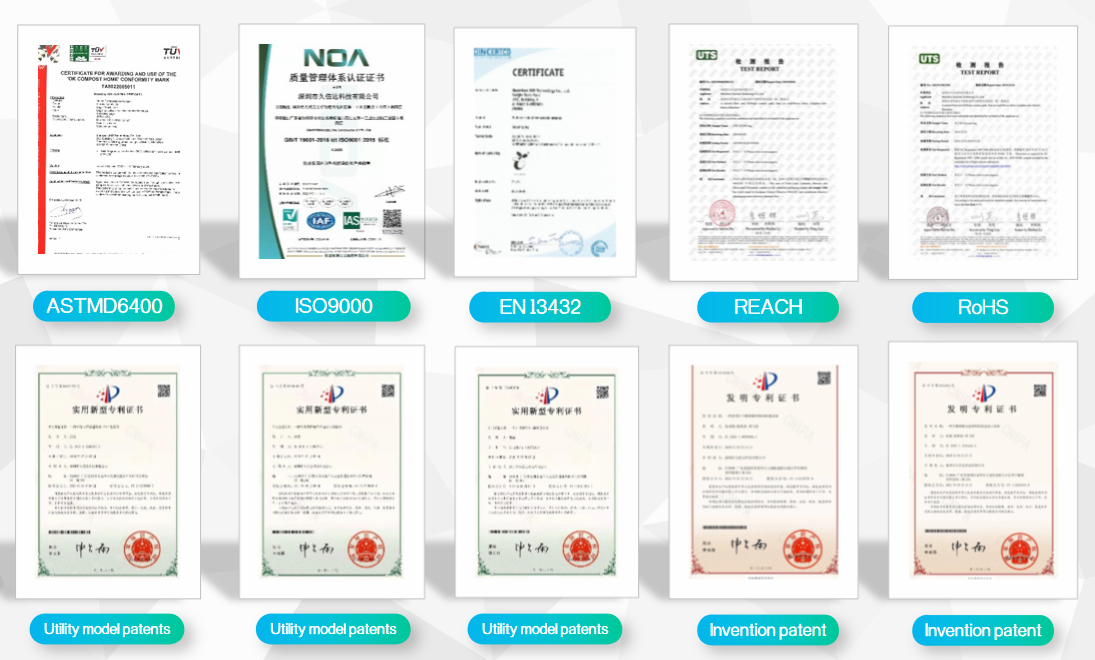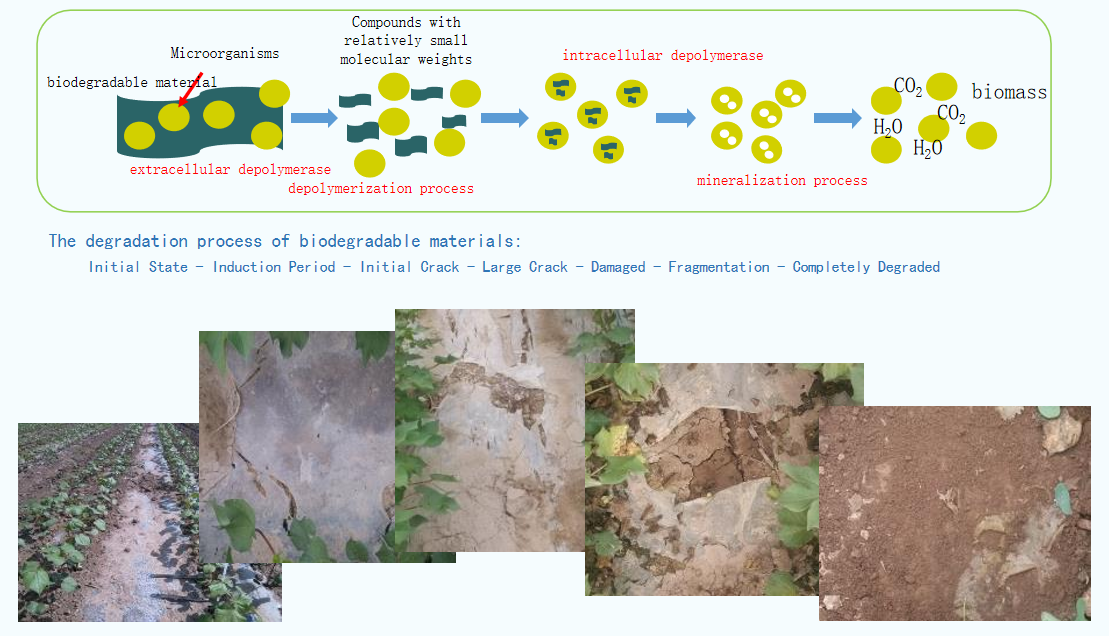Product Details

| PBAT+PLA | PBAT+PLA+starch/glycerol | Remark | |
| Strength | high | Low | low starch strength |
| Texture | stiff | soft | |
| transparency | 80~90% | Poor, yellow or white | |
| Feature | good | poor | The defects of starch limit its application scenarios |
| Shelf life | long | short | Water-absorbing properties of starch, resulting in accelerated hydrolysis of the material |
| food contact | good | poor | Starch is easy to separate out, and it is easy to cause some harmful substances to separate out. |
| odor | light | heavier | Starch burnt smell during processing |
| Processing environment | good | poor | Starch easily breeds mosquitoes and mice in workshops |

| Compare items | Biodegradable new material | traditional polyolefin | Remark |
| biodegradability | Degrades into water and CO2 under composting conditions | non-degradable | White pollution |
| thickness | 8-200 micron membranes can be produced | Can produce 4 microns | Can be used in the field of mulch |
| transparency | Adjustable, translucent to opaque adjustable | Good transparency and adjustable | Transparency tailored to client requirements |
| Gloss | High gloss, bright and matt adjustable | Good gloss, adjustable | |
| Mechanical strength | Can meet existing packaging mechanics requirements | high strength | |
| Breathability / Barrier | Breathable film>500, Barrier film<150 | airtight | for fresh-keeping |
| food contact safety | Compliant with FDA and EU food contact requirements | Some plastics contain plasticizers | Can be directly used in food packaging after certification |
| Shelf life | Shelf life up to 2 years | Shelf greater than 5 years | |
| Conditions of Use | –20—60℃, not resistant to acid and alkali | –50—70℃, acid and alkali resistant | |
| Material composition | PBAT+PLA+functional powder | PE(LDPE\HDPE) | |
| scrap recycling | Blended scraps can be recycled | corners can be recycled | |
| Processing energy consumption | High efficiency, large output and low energy consumption | Relatively high energy consumption |
Safety of food
Vest packaging bags, organic food, fresh-keeping/paper-plastic composite, lamination, etc., sanitary packaging materials, protective pads, health, medical treatment, etc.
Industrial package
Clothing, Express, Bubble, Electronics, Home Furnishing, Bone Bag, Pet Supplies, Sports Brands, Stretch Film, Shrinkage, Adhesive Paper
Agriculture/Marine
Plastic film, fishing, ship transportation, aquarium
Other
Injection molding, sheet, spinning, 3D printing, casting


Biodegradation related standards
GRS/EN 13432/ASTM D6400/AS 4736/5810/GB/T 19277.1

Biodegradation related standards
home compost
Temperature 28 ℃, humidity 90%, 360d degradation
marine degradation
PCL, PHA, PGA are marine degradable


Various material properties
PBAT: Structure PTA (terephthalic acid, 25%) + AA (adipic acid, 20%) + BDO (1,4-butanediol, 55%)
PLA: its synthesis methods are divided into direct polymerization and ring-opening polymerization
Direct polymerization: due to its relatively stable molecular structure, the molecular weight of the obtained polylactic acid is not large
Ring-opening polymerization: Lactic acid is first polymerized into lactide, and then polylactic acid with larger molecular weight is obtained by ring-opening polymerization of lactide.
It is divided into right-handed polylactic acid (PLLA) and left-handed polylactic acid (PDLA)
PCL: obtained by binary copolymerization, easy to form film, with good flexibility and processability
PHA: 100% biological source, its synthetic monomers are directly obtained from biological fermentation and can be degraded in the ocean
PPC: its production process can fix about 40% carbon dioxide
PGA: high crystallinity, excellent barrier properties, similar to PLA, higher strength, better heat resistance
PVA: can be degraded only in a specific environment
Materials: PBAT, PLA and other materials have different properties and different processing techniques, and need to be modified to have application value. Through blending and modification technology, we can learn from each other’s strengths and broaden the application fields of materials, and realize the diversified development of degradable materials.
Degradable plastic
(a) PE/PP+CaCO3, decomposed into fragments in an acidic environment, can not be degraded into CO2 and H2O eventually, and incineration also produces less toxic and harmful substances.
(b) PE/PP+ST (starch), the starch part can be degraded in the natural environment, but PE still remains in the soil and cannot be degraded, resulting in more serious secondary pollution

Photo-oxygen degradable plastic
Plasticizer (BDP): Under anaerobic or anaerobic conditions, the long chain of molecular chains is broken to achieve the purpose of degradation. No access to anaerobic microorganisms will not work.
Microcapsule photodegraders are organic compounds that connect metal elements and have double bonds. Under sunlight, they form photochemical changes, form free radical compounds, and transfer to hydrogen on polymer molecules, causing molecular chain cleavage, and then complete the polymer. degradation. D2W, P-Life, OxO and other common symbols in the market are all photo-oxidative degradation agents. Add 1%-2% additives to PP and PE materials, which can only be cracked into small fragments and cannot be converted into water and carbon dioxide. , causing more serious pollution of secondary microplastics and affecting the renewability of polyolefin materials; the EU expressly prohibits this material.
Bio-based plastics
High molecular polymers such as PE, PA, PET, ST, PLA, etc., whose polymeric monomers are derived from biological fermentation, rather than through fossil energy, are called bio-based plastics.
Biodegradable plastic
Biodegradable materials are polymer materials that can be degraded or enzymatically decomposed into water and carbon dioxide by chemical, biological or physical action under the action of microorganisms such as bacteria, fungi, and algae.
Representative polymers include PLA, PBAT, PHA, PCL, PPC, PGA, etc.
Completely biodegradable materials are decomposed into carbon dioxide, water and other low molecular compounds by microorganisms under natural conditions, and no toxic and harmful residues are produced during the decomposition process, which is an effective way to thoroughly control residual film pollution.
Completely biodegradable materials are decomposed into carbon dioxide, water and other low molecular compounds by microorganisms under natural conditions, and no toxic and harmful residues are produced during the decomposition process, which is an effective way to thoroughly control residual film pollution.








